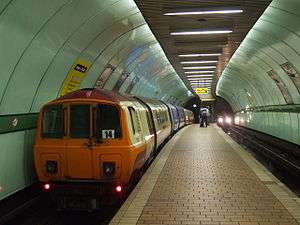Glasgow Subway
 | |
| Overview | |
|---|---|
| Locale | Glasgow, Scotland |
| Transit type | Rapid transit |
| Number of lines | 2 |
| Number of stations | 15 |
| Daily ridership | 39,980 (2013/2014)[1] |
| Website | SPT Subway |
| Operation | |
| Began operation | 1896 |
| Operator(s) | SPT |
| Technical | |
| System length | 6.5 mi (10.5 km) |
| Track gauge | 4 ft (1,219 mm) |
| Electrification | 600 V DC third rail |
The Glasgow Subway is an underground metro line in Glasgow, Scotland. Opened on 14 December 1896, it is the third-oldest underground metro system in the world after the London Underground and the Budapest Metro. It is the only heavy rail underground metro system in the United Kingdom outside London, and also the only one in the United Kingdom which operates completely underground. It is also one of the very few railways in the world with a track running gauge of 4 ft (1,219 mm). Formerly a cable railway, the Subway was later electrified, but its twin circular lines were never expanded. The line was originally known as the Glasgow District Subway, but was later renamed Glasgow Subway Railway. It was so called when taken over by the Glasgow Corporation who renamed it the Glasgow Underground in 1936. Despite this rebranding, many Glaswegians continued to refer to the network as "the Subway". In 2003 the name "Subway" was officially readopted by its operator, the Strathclyde Partnership for Transport (SPT). A £40,000 study examining the feasibility of an expansion into the city’s south side is in progress.[2]
The system is not the oldest underground railway in Glasgow: that distinction belongs to a 3.1 mi (5.0 km) section of the Glasgow City and District Railway opened in 1863, now part of the North Clyde Line of the suburban railway network, which runs in a sub-surface tunnel under the city centre between High Street and west of Charing Cross. Another major section of underground suburban railway line in Glasgow is the Argyle Line, which was formerly part of the Glasgow Central Railway.
The Subway runs from 06:30 to 23:40 Monday to Saturday and 10:00 to 18:12 on Sunday.
Route
The route is a loop almost 6.5 miles (10.5 km) long and extends both north and south of the River Clyde. The tracks have the unusual narrow gauge of 4 ft (1,219 mm), and a nominal tunnel diameter of 11 feet (3.35 m), even smaller than that of the deep-level lines of the London Underground (11 feet 8 1⁄4 inches or 3.56 metres at their smallest); the rolling stock is considerably smaller.
The system describes itself as two lines, the Outer Circle and Inner Circle, but this simply refers to the double track, having trains running clockwise and anticlockwise respectively around the same route although in separate tunnels. Stations use a variety of platform layouts including single island platforms, opposing side platforms and in some stations such as Hillhead one side and one island platform.
The subway’s running lines are entirely underground, but the maintenance depot at Broomloan Road (located between the Govan and Ibrox stations) is above ground, as was the earlier depot, also at Govan. Prior to modernisation, trains used to be hoisted by crane onto and off the tracks. Modernisation brought the installation of points and a ramp between Govan and Ibrox where trains can exit the tunnel system to terminate for engineering, cleaning or storage.
The system is owned and operated by the Strathclyde Partnership for Transport (SPT), formerly Strathclyde Passenger Transport, and carried 13.16 million passengers in the period 2005-06.[3] The Subway has been policed by British Transport Police since 2007.[4]
History
1896–1977
The Glasgow District Subway Company began construction of the underground in 1891 and opened on 14 December 1896,[5] the subway was powered by a clutch-and-cable system, with one cable for each direction. The cable was driven from a steam-powered plant between West Street and Shields Road stations. There was no additional cable to allow trains to reach the depot; instead, they were transferred to and from the running lines by crane operating over a pit at the Govan workshops. This also meant that the two tracks could be completely separate, with no points anywhere. The company's headquarters were in the upper rooms at St Enoch subway station; this distinctive ornate building still stands in St Enoch Square and was subsequently used as a travel information office by SPT and is now a coffee shop.[6]
When the Subway first opened, single-carriage four axle (twin truck) trains were operated.[7] Late in the evening on the opening day, after 11pm, one car laden with 60 passengers was run into by another under the River Clyde. Four people were injured, one being taken to the infirmary.[8] This entailed the closure of the Subway until 19 January 1897.[9] The 20 original wooden bodied carriages were built by the Oldbury Railway Carriage and Wagon Company, of Oldbury, Worcestershire. Many continued in service until 1977 in an upgraded form. A further 10 were delivered by the same manufacturer in 1897. From 1898, second four axle (trailer) carriages without a cable gripper mechanism were added, though they were considerably shorter than the front (gripper) carriage. These additional carriages, eventually numbering 30, were built by Hurst Nelson & Company, Motherwell, Lanarkshire. These carriages were soon expanded to match the length of the front carriages, although carriage 41T has been restored to its original length and cut longitudinally and number 39T is preserved in the Riverside Museum. Carriage 41T was on display at Buchanan Street subway station but was removed with the latest round of station modernisations. Enquiries with station staff on 27 September 2017 reveal that the removal was conducted in the middle of the night at the end of 2015 or the start of 2016. The removal sparked protests. Its location is currently unknown. Most of the gripper carriages were subsequently converted to electric traction in 1935. All carriages were originally built with lattice gates (instead of doors) at the ends; many were converted to air-operated sliding doors in the 1960s, but a few retained the gates until 1977.[10]
All 15 stations were built with island platforms. The trains were thus built with doors on one side only. Power for the electric lighting in the trains was supplied by two parallel wall-mounted rails (known as "T-irons") at window level on the non-platform side of the trains; trains were originally equipped with wheels to pick up the electricity but changed to skids at electrification.[11] The trains remained cable-hauled until 1935, though the anachronistic way of supplying power for the lighting continued until 1977. The lighting circuit was also part of the operation of the signalling system.[12]
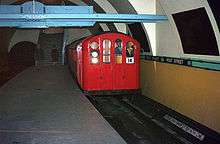
Opening times of the Glasgow subway have varied through the years, now open 6.30am–23.40am every day and 10.00am–6.00pm on Sunday following a trial period between April 2011 and 2012 when the subway was open from 9.00am–6.30pm.
Glasgow Corporation took over the company in 1923[13] at a cost of £385,000 (equivalent to £20,151,702 in 2016).[14] In 1935, the existing trains were converted to electric power delivered by a third rail at 600 volts, direct current.[15] From March until December 1935, clockwise trains were cable-hauled, whilst anti-clockwise ones were electric. The conversion to electric traction cost £120,000[16] (equivalent to £7,644,721 in 2016).[14] The last cable drawn car service was on 30 November 1935, and was driven by Robert Boyd.[17]
The trains lost their original plum and cream-coloured liveries, being painted red and white instead. From the 1950s the trains became all red—in a shade similar to that of London buses. During the early 1970s, trailer carriage number 41 was repainted in the original 1896 livery.
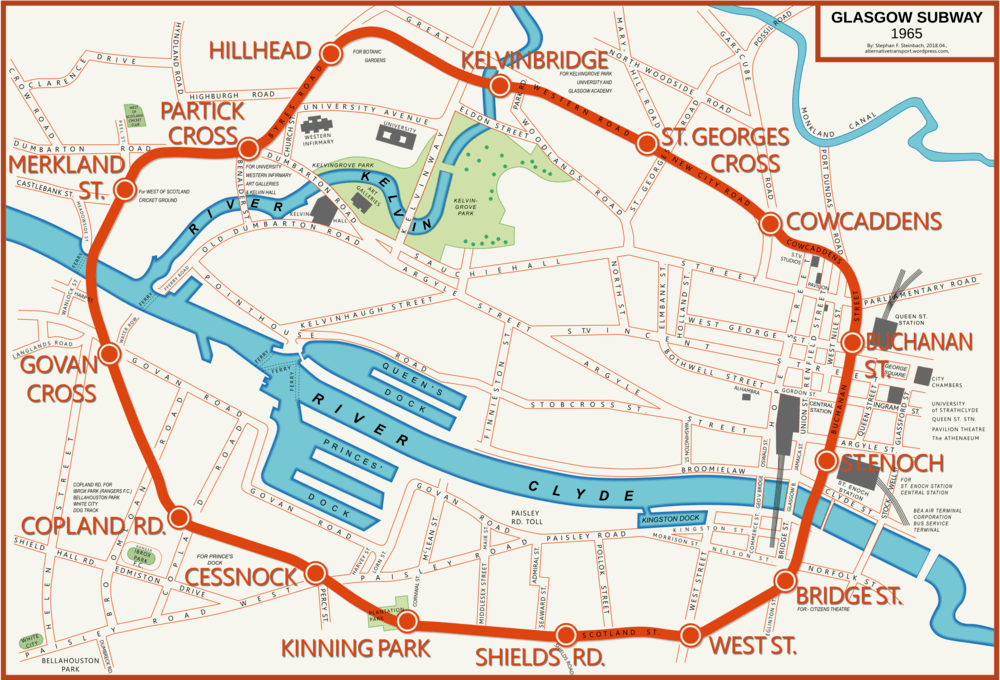
After the Beeching Axe of the 1960s, both St Enoch and Buchanan Street mainline stations were closed and demolished, However, there was no direct connection between the underground and mainline stations of Buchanan Street as they were over 0.5 kilometres (0.31 mi) distant. The Subway had had no direct passenger connection to the national railway network—a major weakness—although Buchanan Street and Merkland Street stations were a short walk from Queen Street and Partickhill British Rail stations respectively.
Before the 1977–1980 modernisation, the stations had a distinctive earthy odour. The trains (mostly dating back to 1896) were always formed with two carriages—the front (motor) carriage with red leather seats and the rear (trailer) carriage with brown leather seats.[15] Smoking was permitted in the rear carriage only. The backs of the seats were attached to the sides of the carriages, which moved semi-independently from the floor (to which the seats themselves were attached); passengers were rocked forwards and backwards while the carriage 'shoogled' them around. Passengers always entered at the middle of the train ("Q[ueue] Here" signs were painted on the platforms), leaving by the front door of the front carriage or the rear door of the rear carriage.
By the 1970s, the stations were very dilapidated. Stations were marked with circular signs often attached to lampposts. This sign had a white background in the top three quarters (containing a large red letter "U") and black in the bottom quarter (containing the word "UNDERGROUND" and an arrow to the station entrance). No station had an escalator; Kelvinbridge had a lift. Each station had a ticket office (often very small, little more than a booth with a window). The ticketing system was identical to that of most cinemas of the era, with tickets emerging from slots in the counters of the station ticket offices (the words "Control Systems Ltd" or "Automaticket Ltd" were printed on all tickets). Tickets were invariably collected on leaving the train. From the time of being taken over by the Corporation until 1977, the staff were issued with tramway uniforms; these were dark green and had a black braid on the cuffs which had been introduced at the time of the funeral of Queen Victoria in 1901.[18][19]
Glasgow's Museum of Transport has an area dedicated to the subway, with models showing the operation of the clutch-and-cable system, as well as a full-scale replica of part of a subway station, complete with different rolling stock of the pre-modernisation era.
Modernisation (1977–1980)
By the 1970s, use of the Subway had declined significantly. This was caused partly by the closure of some of the dockyards and by widescale demolition of tenements south of the River Clyde. The original carriages, mostly dating back to 1896, were still in use, though adapted for electric traction in 1935. Breakdowns were becoming increasingly frequent; because trains could only be removed from the tracks to the depot by crane, a single inoperable train could cause major delays. The future of the Subway became a major issue for the Greater Glasgow Passenger Transport Executive, which took over responsibility for the line from Glasgow Corporation in the late 1960s.
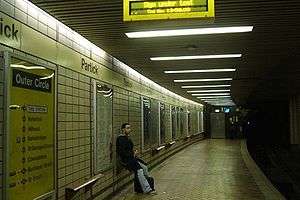
On 24 March 1977, cracks were noticed in the roof of Govan Cross station, leading to suspension of services until 2 May. The service resumed with only four trains per circle. On 21 May 1977, the system was shut down eight days prematurely for a major refurbishment and modernisation; the date was brought forward because of the appearance of more cracks in the Govan Cross roof. Badly deteriorated tunnels were repaired; stations were rebuilt and enlarged, with additional platforms at Buchanan Street, Partick, Govan, Ibrox, Hillhead and St Enoch. The entrance to Kelvinbridge was reversed, with a new entrance and car park built at South Woodside Road, an escalator to Great Western Road and stairs down to the west end of the platform; the former entrance and stairway at the east end became an emergency exit, and the lift was withdrawn from service. Merkland Street station was closed; a new station to the north was built at Partick to provide an interchange with the North Clyde Line of the suburban rail system. The site of Merkland Street can be noticed by the characteristic hump and the larger-diameter tunnel with both tracks. Many fittings from Merkland Street were used to build a replica pre-modernisation station at the Glasgow Museum of Transport, containing three preserved cars.
A further interchange via moving walkway was installed between Buchanan Street station and Queen Street mainline station as part of the modernisation.

In August 1977, all redundant fittings and equipment from the old system were sold at a public sale at Broomloan Works. During the 1977–1980 modernisation, two Clayton battery locomotives were used by the contractors Taylor Woodrow to haul construction trains.[20]
Heavier track was installed although still at the unique, 4 ft (1,219 mm) gauge, the original Broomloan Depot was modernised and equipped with connecting tracks with points to replace the crane transfer, and a new electrical supply from Westinghouse Electric Corporation was installed. A new ticketing system, provided by Crouzet, with passenger-operated ticket vending machines and automatic turnstile barriers, replaced the old, perforated cinema-style tickets and conductors. The post-1980 yellow tickets have since been replaced by a newer system, issuing magnetic stripe card tickets.
The modernised system uses automatic train operation with the driver only responsible for closing the doors pressing a "start" button in normal operation.[21]
Since modernisation
The line was formally reopened by Queen Elizabeth II on 1 November 1979. However, rebuilding work was still incomplete, and the line did not reopen to passengers until 16 April 1980. Thirty-three new carriages were built by Metro Cammell at its Washwood Heath works in Birmingham, and equipped with GEC electric motors. The exterior design of the trains was carried out in partnership with Glasgow School of Art, which, according to SPT publicity films of the day, was largely responsible for the trains' "cute" appearance. Eight additional centre-trailer carriages were built in 1992 (the body shells by Hunslet Gyro Mining Transport Ltd in Leeds for completion by Hunslet-Barclay Ltd in Kilmarnock), making all trains three carriages long. Smoking has never been permitted on the modernised system.
A new corporate identity was introduced (following contemporary fashions of the 1970s), with trains painted bright orange, stations largely rebuilt with dark brown bricks, orange-yellow wall tiles and other surfaces in off-white, plus brown uniforms for the staff. Large, illuminated orange "U" signs were placed at station entrances (since removed, with the re-adoption of the name "Subway"). Since the 1990s, ongoing renovation work has resulted in most stations adopting individual colour schemes. The trains' initial orange livery of 1980 (with a white stripe) was soon replaced by a darker, more durable shade of orange, itself now being replaced by SPT's latest carmine-red and cream livery.
The system was resignalled using Vital Processor Interlocking in 1996 and subsequently an upgraded Supervisory & Control System was installed.[22]
Future development
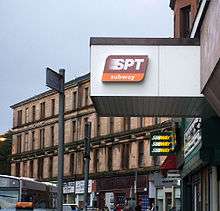
The Glasgow Subway system is the only metro system never to have been expanded from its original route in almost 120 years. In early 2005, SPT announced that they would employ consultants to look into extending the system in the West End, East End, South Side and Glasgow Harbour areas of the city. The extension would take advantage of existing unused tunnels underneath the city, and there is a possibility that roads would be dug up to install tunnels before being replaced and resurfaced (cut-and-cover tunnelling).
On 14 March 2007, SPT announced the plans that the consultants had recommended. These included major refurbishment of the existing rolling stock and stations, at an overall cost of £270 million.[23] The expansion of the existing network was also considered at a cost of £2.3 billion, including a new East End Circle, with seven new stations at St. Mungo's, Onslow, Duke Street, Celtic Park, Dalmarnock, Newhall and Gorbals. The aim was to improve transport links in an area of the city which is currently poorly served by rail, in the hope that this would aid regeneration, and the city's 2014 Commonwealth Games bid. This circle would interchange at Cowcaddens, Buchanan Street and St Enoch. Other proposals include extending the system southwards to Cathcart and further westwards to the SECC and Maryhill using an older railway line.
In 2007, SPT produced a report that showed huge support for a Subway extension. Councillor Alistair Watson of the SPT stated:
we want what you want. This city needs a world-class Subway system. That’s what our passengers deserve. I realise an extension won’t come cheap and we still have lots of hurdles to overcome but, in my view, what the public wants, the public should get. This is a ringing endorsement from the people who would use the extended Subway.[24]
The plans were expected to take twelve years, but never came to fruition. There is a live petition for an extension of the Glasgow Subway.
New electronic destination signs were installed in the stations in 2008.
The Partick station modernisation project was completed in 2009, and resulted in a complete redevelopment at the station, which hosts a railway station, a subway station and a bus terminal on the outside.
In March 2016, Strathclyde Partnership for Transport (SPT) awarded contracts to Stadler and Ansaldo STS for the supply of 17 new trains for the Subway. The first of the new trains is expected from 2020.[25]
If the Crossrail Glasgow project is approved, then West Street station will be redeveloped as an interchange between the new surface railway and the Subway. This was to have been completed by 2010, but has yet to begin—probably because funding has not been made available.
Further modernisation
In April 2010, Strathclyde Partnership for Transport approved outline plans for a £290 million upgrade of the Subway—the first since the comprehensive modernisation of the late 1970s.[26] The proposals were approved by the Scottish Government in March 2011, and changes to be brought in include:
- integrated smartcard ticketing
- new driver-less trains
- improved signalling with automation
- refurbishing all subway stations, including making stations more accessible, as well as safer with platform screen doors.[27]
The first station to be modernised was Hillhead. This began in 2011 and finished in 2012. The modernisation of the station included the retiling of all the walls and floors, the replacement of escalators, a new ticket office, better way finding and also a piece of public art.
Further plans were announced to modernise Ibrox and Kelvinhall stations before the 2014 Commonwealth Games in Glasgow. Furthermore, all other stations were planned to receive updated branding prior to modernisation work being carried out on them, so as to achieve unity in design.
Connections
Before the modernisation, the Subway offered no formal connections to other transport at ground level, although in practice two stations, Merkland Street and Buchanan Street, were only a short walk from British Rail stations. These links were improved at this modernisation:-
- At Partick, the system connects with the North Clyde line and Argyle lines of the Glasgow suburban railway network. This was achieved by physically relocating the original railway station at Partickhill, as well as moving and renaming the Merkland Street station.
- A connecting moving walkway, linking Buchanan Street station to Queen Street main-line station.
- Glasgow Central and Argyle Street railway stations (for the Argyle Line) are both a short walk from St. Enoch Centre, and most stations connect with bus routes.
Stations

The stations of the Subway, in clockwise order from Partick.
| Name | Image | Transport Interchange | Serves | Usage [1] |
|---|---|---|---|---|
| Partick (Replaced Merkland Street (closed 1977) in 1979) |
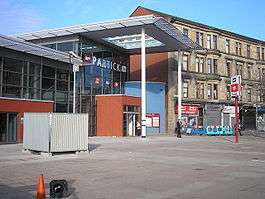 |
Riverside Museum Hamilton Crescent Cricket Ground |
966,192 | |
| Kelvinhall (named Partick Cross until 1977) |
Kelvin Hall Kelvingrove Art Gallery and Museum Kelvingrove Park University of Glasgow Western Infirmary |
661,359 | ||
| Hillhead | 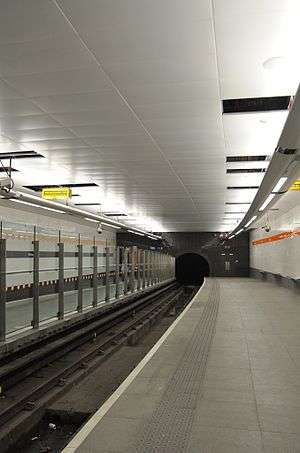 |
University of Glasgow Glasgow Botanic Gardens Byres Road Ashton Lane |
1,852,342 | |
| Kelvinbridge | 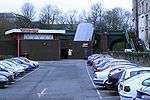 |
Great Western Road Kelvingrove Park University of Glasgow St Mary's Cathedral The Glasgow Academy |
941,008 | |
| St George's Cross | 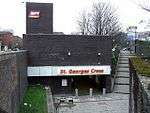 |
Great Western Road Firhill Stadium |
524,638 | |
| Cowcaddens |  |
The Willow Tearooms Glasgow School of Art Glasgow Caledonian University Glasgow Kelvin College Glasgow Sculpture Studios Gallery |
460,577 | |
| Buchanan Street | 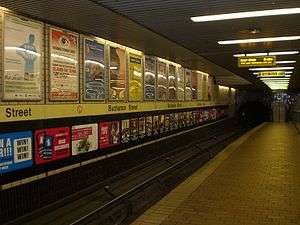 |
Buchanan Street Buchanan Galleries Glasgow City Chambers George Square Glasgow Royal Concert Hall Cineworld |
2,420,995 | |
| St Enoch | 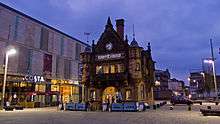 |
St. Enoch Centre St Andrew's Cathedral River Clyde |
1,908,029 | |
| Bridge Street | 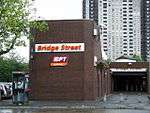 |
O2 Academy Glasgow Glasgow Sheriff Court |
380,187 | |
| West Street |  |
96,593 | ||
| Shields Road | 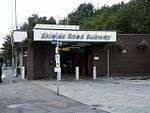 |
Scotland Street School Museum | 446,491 | |
| Kinning Park |  |
243,074 | ||
| Cessnock | 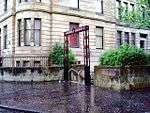 |
Glasgow Science Centre (including Glasgow Tower, the IMAX cinema) BBC Scotland STV (TV network) |
442,523 | |
| Ibrox (named Copland Road until 1977) |
 |
Ibrox Stadium | 487,543 | |
| Govan (named Govan Cross until 1977) |
 |
Govan Old Parish Church | 925,541 |
Rolling stock
Fares and ticketing
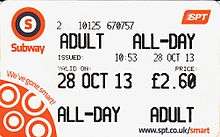
A ticket on the Glasgow Subway, unlike many other underground systems, does not use a distance-based fare structure. A ticket allows passengers to stay on the underground for as long as they like.
With the introduction of Smartcard technology, known as Bramble, there is a two-tier fare structure. There is a Single fare option, with Adult (Plastic) Smartcard fares being over 10% cheaper than 'Disposable' paper tickets. Smartcards have a daily cap which is cheaper than the Disposable return ticket and significantly cheaper than the Disposable All Day Ticket. A Smartcard is required for any form of Season Ticket (7 Day, 4 Week, 6 Month, 1 Year).[28]
Smartcards are available online for free, taking up to 10 working days for delivery, or for £3 from stations.[28]
All tickets are available at any station either through a machine or at the ticket office. Tickets must be 'tapped' on the card reader to validate the ticket and must be retained for exit.[29]
The Zonecard is also valid on the Subway as long as it is valid in zones G1 or G2.[30]
The concession fare is for disabled or elderly individuals who are holders of a National Entitlement Card that has been issued by SPT[31].
Subway Fares effective as of Wednesday 31 May 2017:
| Ticket[32] | Smartcard | Disposable | |||
|---|---|---|---|---|---|
| Adult | Child | Adult | Child | Concession | |
| Single | £1.45 | £0.70 | £1.65 | £0.70 | £1.00 |
| Return | N/A | N/A | £3.10 | £1.35 | £1.40 |
| Disposable All Day | N/A | N/A | £4.00 | N/A | N/A |
| Smartcard Daily Cap | £2.80 | £1.35 | N/A | N/A | N/A |
| 7 day ticket | £13.00 | £6.50 | N/A | N/A | N/A |
| 28 day ticket | £50.00 | £25.00 | N/A | N/A | N/A |
| 6 Month ticket | £250.00 | £125.00 | N/A | N/A | N/A |
| 12 Month ticket | £450.00 | £225.00 | N/A | N/A | N/A |
| Park & Ride | 1 day: £5.20; 7 day: £25.00; 28 day: £95.00; 6 month: £500.00; Annual: £900.00 | ||||
Nicknames
The origin of the Subway's supposed, but seldom used outside the press, nickname, "The Clockwork Orange" (coined from the title of the book and film A Clockwork Orange) is subject to dispute. Some believe that it was originally coined by the media of the period, whilst others credit it to the then chairman of British Rail, Sir Peter Parker, who was quoted in a late 1970s publicity video of the new trains as saying "so these are the original Clockwork Orange".[33] Most of its carriages were painted orange (although called "Strathclyde PTE red" because "Orange" has sectarian connotations in Glasgow), the corporate colour of Greater Glasgow Passenger Transport Executive at the time. Most of the units have since been replaced with a new colour scheme of carmine and cream with a thin orange band, which will be implemented progressively throughout the fleet as cars are refurbished.
While the "Clockwork Orange" nickname is often used in tourist guidebooks and local literature, it is virtually unused by locals,[34][35][36] who will refer to the system simply as "the Subway", "the Tube" or, less commonly, "the Underground". Prior to the introduction of new trains in the 1970s the name "Shoogly Train" was used because the design of the cars allowed a degree of movement or "shoogle" between the backrest and squab of each seat.[37]
"The Underground Song"
The celebrated Glaswegian writer and broadcaster Cliff Hanley composed a satirical song about the pre-modernisation era Subway entitled "The Underground Song". It was popular as a stage piece performed by the comedians Rikki Fulton and Jack Milroy in their Francie and Josie act.[38]
The chorus of the song is:
There's Partick Cross and Cessnock, Hillhead and Merkland Street,
St George's Cross and Govan Cross where all the people meet;
West Street, Shields Road – The train goes round and round;
You've never lived unless you've been on the Glasgow Underground.[38]
The Subcrawl
The Glasgow Subway and its adjacent public houses are the focal point of a pub crawl known as the Subcrawl. Participants buy an all day ticket, disembark at each of the 15 stations and have a drink in the nearest bar.[39] Two of the stations (West Street and Shields Road) are not very near a pub or bar; however, Subcrawls are popular amongst young Glaswegians and especially students at the city's universities. During the journey between stations, participants are usually required to stand in the train and not hold onto any supports, known as Subsurfing. A subcrawl usually takes a whole day, and completing a crawl (drinking in the same pub one started in) is regarded as quite an achievement.
iShoogle
In September 2012 SPT launched an app for Apple iPhones and Android smartphones called iShoogle which allows users to "Check in" using Facebook at Subway stations, Shoogle guide does a search of local area amenities such as bars, shops, cafes, banks and entertainment that are near subway stations, there are local area maps using Apple Maps or Google Maps as well as the official SPT map and timetables of the first and last trains and photos from SPT's archives. The app also has facts about the Subway.[40][41][42]
See also
References
- 1 2 "Annual_Report_2013-14" (PDF). Retrieved 2015-04-24.
- ↑ "SPT Interchange Issue 9". Archived from the original on 2007-06-12.
- ↑ "SPT passenger facts". Archived from the original on 2008-05-11.
- ↑ 'Police For Glasgow Subway', The Times, 3 January 2007
- ↑ "The Evening News". Edinburgh Evening News. Scotland. 14 December 1896. Retrieved 4 February 2017 – via British Newspaper Archive. (Subscription required (help)).
- ↑ "Subway - History". Archived from the original on 2006-08-20.
- ↑ Casely, G. and Hamilton, Wm., I belong to Glasgow: The human history of the Glasgow Underground, Nexus Press Ltd, Glasgow (2nd edition, 1976), p. 28
- ↑ "A collision under the Clyde". Yorkshire Evening Post. England. 15 December 1896. Retrieved 4 February 2017 – via British Newspaper Archive. (Subscription required (help)).
- ↑ Irlam, Michael J. "A Scottish District Subway". Mike's Railway History. Retrieved 2007-01-10.
- ↑ "Subway - History". Archived from the original on 2007-05-22.
- ↑ Casely and Hamilton, ibid, p. 43
- ↑ "Subway - History". Archived from the original on 2007-05-21.
- ↑ "Glasgow Corporation's Venture. Taking over the Subway Railway". Dundee Courier. Scotland. 20 March 1923. Retrieved 4 February 2017 – via British Newspaper Archive. (Subscription required (help)).
- 1 2 UK Retail Price Index inflation figures are based on data from Clark, Gregory (2017). "The Annual RPI and Average Earnings for Britain, 1209 to Present (New Series)". MeasuringWorth. Retrieved 6 November 2017.
- 1 2 Casely and Hamilton, ibid, p. 45
- ↑ "Electrification of Subway: Official Inspection". The Scotsman. Scotland. 27 March 1935. Retrieved 4 February 2017 – via British Newspaper Archive. (Subscription required (help)).
- ↑ "Last Cable Drawn Car". Falkirk Herald. Scotland. 4 December 1935. Retrieved 4 February 2017 – via British Newspaper Archive. (Subscription required (help)).
- ↑ "Subway - Chronology". Archived from the original on 2007-07-07.
- ↑ "Glasgow Transport Memorobilia". Archived from the original on 17 April 2007. Retrieved 31 January 2007.
- ↑ Subway replacement battery locomotives, Strathclyde Partnership for Transport , 13 June 2008
- ↑ Glasgow Subway Automatic Train Operation, Institute of Railway Signal Engineers, January 2006
- ↑ Gerrard, Ed; Chaffe, David; Peat, Watson (September–October 2007). "Upgraded Supervisory and Control System brings Operational & Maintenance Benefits to Glasgow Subway" (PDF). IRSE Newsletter, Hong Kong Section. 33: 1–3. Retrieved 2010-04-13.
- ↑ "News". Evening Times. 2007-03-14. Archived from the original on 9 August 2011. Retrieved 2011-08-10.
- ↑ "Survey shows SPT 'in tune' with the public | SPT | Corporate Information | Strathclyde Partnership for Transport". SPT. Retrieved 2017-09-02.
- ↑ "New Trains Unveiled". 2016-03-04. Retrieved 2016-06-28.
- ↑ "SPT approves £290m modernisation of the Subway, 16 April 2010". BBC News. 2010-04-16. Retrieved 2011-08-10.
- ↑ "SPT Projects - Subway Modernisation". Spt.co.uk. 2011-04-15. Retrieved 2011-08-10.
- 1 2 "Subway fares are changing". Strathclyde Partnership for Transport. Retrieved 2014-01-06.
- ↑ "SPT Subway Smartcard". Strathclyde Partnership for Transport. Retrieved 2014-01-06.
- ↑ "ZoneCard". Retrieved 2014-01-06.
- ↑ "Concessions". Retrieved 2016-10-25.
- ↑ "Tickets". Strathclyde Partnership for Transport. Retrieved 2017-05-31.
- ↑ "Glasgow Transport 1980 - Part 2, Glasgow Underground". YouTube. 2007-01-30. Retrieved 2011-08-10.
- ↑ "The Cable Car Home Page - Cable Car Lines in the UK". Cable-car-guy.com. Retrieved 2011-08-10.
- ↑ "Racing a clockwork orange". MetaFilter. Retrieved 2011-08-10.
- ↑ "Glasgow Guide: Pots And Pans Hen Night - Glasgow Guide Boards". Discuss.glasgowguide.co.uk. Retrieved 2011-08-10.
- ↑ iShoogle - Android Apps on Google Play
- 1 2 YouTube - Francie and Josie - The Underground Song
- ↑ Glasgow sub-crawl: a pub crawl via the city's underground, The Guardian, 30 November 2012
- ↑ "SPT launches pioneering mobile app". spt.co.uk. 25 September 2012. Retrieved 25 September 2012.
- ↑ "iShoogle The shoogle guide to Glasgow". Google Play. 25 September 2012. Retrieved 25 September 2012.
- ↑ "iShoogle for iPhone 3GS, iPhone 4, iPhone 4S". itunes store. 25 September 2012. Retrieved 25 September 2012.
Further reading
- J. Wright and I. Maclean, Circles under the Clyde: A history of the Glasgow Underground, Capital Transport, 1997, ISBN 1-85414-190-2
- Hunt, John (4–17 June 1997). "Running like clockwork!". RAIL. No. 306. EMAP Apex Publications. pp. 30–34. ISSN 0953-4563. OCLC 49953699.
- G. Watson, Glasgow Subway Album George Watson, 2013, ISBN 978-1-906311-06-3
- Bruce, W.R. (1936). Thomas, P.W., ed. Electrification of the Glasgow District Subway (Book). Transactions, the Institution of Engineers and Shipbuilders in Scotland. 79. Glasgow, UK: IESIS. p. 131.
External links
| Wikimedia Commons has media related to Glasgow Subway. |
Route map:
- Photos of the Glasgow Subway Before/During Modernisation, ca. 1977-80
- Strathclyde Partnership for Transport — Subway
- Photographs of Glasgow’s rolling stock
- Article and photo gallery about the Merkland Street station (now Partick)
- A website displaying many different items from the Glasgow Subway
- Collection of Google Earth locations of SPT Subway stations (Requires Google Earth software) from the Google Earth Community forum.
- Glasgow Page at Urbanrail.net
- Details and pictures of the Subway renovation in the 1970s
- Architecture photo series of all stations of the Glasgow Subway as per 03/2014
.jpg)
